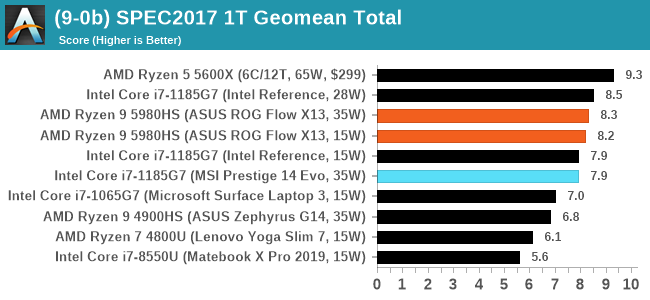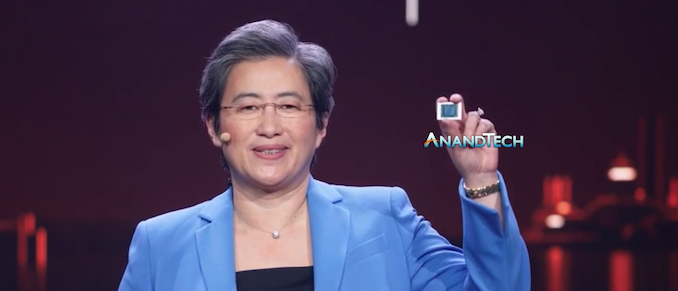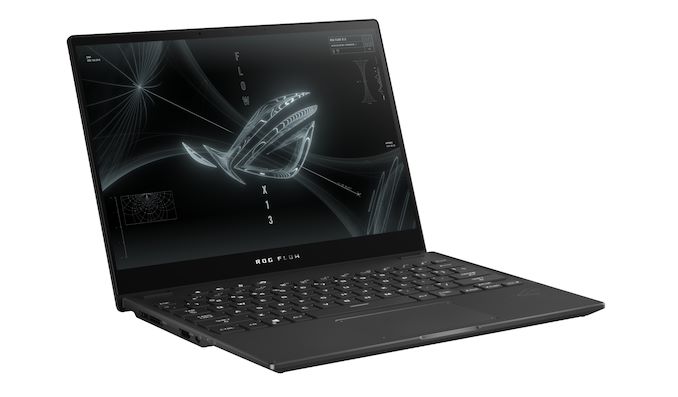AMD Ryzen 9 5980HS Cezanne Review: Ryzen 5000 Mobile Tested
by Dr. Ian Cutress on January 26, 2021 9:00 AM EST- Posted in
- CPUs
- AMD
- Vega
- Ryzen
- Zen 3
- Renoir
- Notebook
- Ryzen 9 5980HS
- Ryzen 5000 Mobile
- Cezanne
Focusing on Premium Experiences
The issue with AMD’s notebook strategy through the 2010s was that most users saw the brand as a budget implementation, with low performance and low specifications. Both AMD and its OEM partners were complicit in assisting this projection, using 1366x768 TN screens and slow mechanical hard drives. There were a number of negative feedback loops preventing a nice AMD mobile system from hitting the market, and the only key design wins were from mass corporate sales. With the launch of the first Ryzen Mobile towards the end of the decade, AMD finally had a performance product worthy of attention, and the company has had a steady improvement generation-on-generation, convincing its OEM partners to come along and take advantage of the performance uplift for their customers.
AMD’s historic lows in that 2010 decade were performance, specifications, and battery life. With Ryzen 4000 Mobile, from last generation, AMD had a product that could dispel all those assumptions, and we saw critical acclaim put upon devices like the Lenovo Slim 7 Yoga, and the ASUS Zephyrus G14. From our review of the new generation today, Ryzen 5000 Mobile, the whole strategy that AMD is playing has finally come into focus.
AMD stated that the new generation Ryzen 5000 Mobile processors were in the lab and up-and-running only two months after Ryzen 4000 Mobile launched. AMD made both sets of processors pin-compatible, allowing OEM partners to build designs that could be used for either processor family. The key here that I’ve realized is that AMD’s ultimate goal with these was to build a strong Ryzen 5000 Mobile family, and Ryzen 4000 Mobile was an option for partners to take baby steps, but the main goal was Ryzen 5000, with Zen 3. AMD’s statement of already having over 150+ system designs in the works with Ryzen 5000 Mobile, another +50% over the previous generation, along with this strategy of having a regular predictable cadence of products through re-use of different hardware elements showcases why Ryzen 5000 Mobile is important to the company. With AMD’s recent supply issues as well, we’re of the opinion that AMD has been stockpiling these Ryzen 5000 Mobile processors in order to enable a strong Q1 and Q2 launch of the platform with stock for all OEMs.
What we tested today is one of the AMD flagships for launch, the Ryzen 9 5980HS inside the ASUS ROG Flow X13. This is a sub-16mm ultraportable gaming laptop with a mid-range discrete GPU installed, an impressive 4K 16:10 Pantone certified IPS display, 32GB LPDDR4X memory and a 1 TB NVMe SSD. It also has an executive feel and design, indicating that both AMD and ASUS want to take this platform to its most premium customers. We’re leaving a full review of the laptop itself for a later date, let us focus on the performance of the processor inside.
The jump from Zen 2 to Zen 3 in the mobile space for AMD is more than just putting in the new cores. The cache adjustment from a split 4+4 MB L3 cache to a unified 16 MB L3 cache enables a better effective latency and less reliance on constantly going out to main memory – AMD is also aggressive on the L3 prefetching policies to drive performance. We can see that the single 8-core CCX has low core-to-core communication latency showcasing that enthusiast level workloads will benefit in more ways than one.
AMD is also piling on improvements to help with power, such as enabling different per-core voltage levels and a more efficient memory controller. Per-core voltage control is something that every modern CPU has to have (or at least islands of CPUs) in order to get the best battery performance. AMD is pairing this with its CPPC2 support, and users will benefit from very quick idle-to-turbo performance for immediate responsiveness.

For our benchmark suite, almost all of our benchmarks show an uplift for the new Ryzen 5000 Mobile series, some considerably so: our compile benchmark is +12%, Corona rendering is +18%, Dolphin emulation +17%, NAMD +8%, Blender +6%. To our surprise our SPEC2006 1T benchmark is +32%, accelerated considerably by the 16 MB L3 cache, but also because these CPUs also support a higher instantaneous power turbo modes than the previous generation. This enables some competitive performance numbers against Intel’s Tiger Lake platform in single thread focused tests (AMD wins on multithread quite easily).
All of these core updates, as well as design wins enabling better hardware under the hood, put AMD’s Ryzen 5000 Mobile series in good stead to power a generation of machines especially as more and more of us work from home. When Intel was in a period of high demand through 2018 and 2019, Intel focused on premium solutions to make the most revenue - Intel’s financials last week showed that the company was selling more and more education-focused low-end notebooks and Chromebooks, now that demand had reduced. We can apply something similar to AMD's current situtation - AMD’s silicon is in high demand for 2021, and so AMD’s target this year would appear to be more mid-range, premium commercial, and enthusiast machines. To reaffirm this, AMD has also promised that we will see notebooks this year paired with the most powerful mobile graphics cards, enabling high-performance gamers to move to AMD. No doubt we will have a number pass through our hands through the year, especially as they hit the shelves starting February.












218 Comments
View All Comments
Tams80 - Monday, February 1, 2021 - link
Yes.Max_Nexor - Tuesday, February 2, 2021 - link
Do you use the Handbrake presets unmodified? If so, have you considered turning off the de-interlacing filter?Filters can slow down transcoding speed dramatically. For example, using the same video and the 480p Discord preset, my system (i7-4790K) transcodes the video at 136 fps. Turning off the interlace detection and the filter results in a speed of 221 fps. Enabling the Denoise filter reduces transcode speed from 221 fps to 15 fps.
Would it not be a better to test just the transcoding speed, without any filters?
Farfolomew - Thursday, February 4, 2021 - link
I'd like to point out that this new Asus Flow X13 laptop is quite unique, and kinda/sorta the first of it's kind of any device out there. How do I mean?Well, up to now, it's been all but impossible to buy a 360-degree hinged TOUCHSCREEN device, that also has a 120hz refresh panel. The only other laptop that had this were ones from HP that had a first-generation Privacy Screen built-in. The privacy screen has a feature that you can turn on and off to enable the viewing angles to be severely limited when desired. The first-gen versions of these had a knock-on effect of running at 120hz, so the touchscreen, 360-degree foldable versions of those are the only other touchscreen laptops with high refresh panels. None of them had particularly great gaming performance, as the best one available was a 4-core Kaby Lake-R powered Ultrabook. The new versions of HP's Privacy Screen no longer run at 120hz, so it was a limited time option.
That's why I'm so excited about this ASUS laptop. I wish it didn't have an external GPU, and only relied on the iGPU instead. But this is as close to my perfect device that has yet been created.
Tams80 - Thursday, February 4, 2021 - link
You do realise that the external GPU dock is optional right? And that *all* models have an Nvidia GTX 1650 in the laptop itself?Farfolomew - Thursday, February 4, 2021 - link
AMD says it had "100 design wins" for Renoir, and 50% more, "150 design wins" for Cezanne. Whatever a "Design Win" means, for that matter.All I know is that when I go into Best Buy to peruse the laptops section, I consistently see two things:
1. While a substantially bigger section, with at least 10x as many different products on display, the "Windows" section is nearly always barren of customers, while the Apple section is most certainly dangerously close to violating every COVID Best Practices known to science.
2. Last I counted, there were about 20-30 Intel Tiger Lake "EVO" branded laptops from all the major OEMs, while I saw less than five, yes FIVE IN TOTAL Ryzen laptops even available for sale. And most of those Ryzen laptops were of the gaming variety. I don't recall seeing a single Ryzen Ultrabook (ie, with just a iGPU).
So I want to know, what is AMD's plans exactly for changing this? They may have an overall better product (albeit at times, only narrowly) than Intel's Tiger Lake, if they can't ship these and get them out in front of the normal Joe customer who doesn't follow the tech scene, they'll never gain significant market share from Intel in the Laptop segment.
GeoffreyA - Sunday, February 7, 2021 - link
I wonder how much of this is due to public perception. Enthusiasts know that AMD is good but most people don't know or care, while some have a vague instinct telling them Intel is first-rate and AMD substandard (corroborated by advice of salespeople in the shop). The laptop seems proper if it's got an Intel sticker, otherwise no good. And that's something which will be very hard for AMD to change. Perhaps fewer Ryzen gaming laptops will help. Even a new logo/sticker for their mobile CPUs, with minimal elegant design.GeoffreyA - Sunday, February 7, 2021 - link
Also, they need to capture the general public's imagination, as silly as that sounds. Just like Samsung did. There was a time when people didn't think much of Samsung (in my country at any rate) but nowadays go into the shop and they've got the best fridges, TVs, and washing machines. Or that's the perception.Farfolomew - Thursday, February 4, 2021 - link
I'm a bit disappointed and left scratching my head regarding the GPU review section of this article. 360p, 480p resolutions ... what are we playing MS-DOS games in EGA 256-color mode?!How did those games even run at such low resolutions? That's mind boggling.
At any rate, it all led to a confusing non-conclusion of what exactly the iGPU performance is on these Cezanne chips, and how it compares to Tiger Lake. Is it better than Tiger Lake or not? How much better than Renoir is it?
I realize this isn't all Ian's fault, as the laptop given to him has a 35W CPU, and we're asking him to compare it to 15W Ultrabooks, etc. But it was still very confusing to me. Hopefully it will become more clear when (and if) AMD Cezanne Ultrabooks come out with 15W parts.